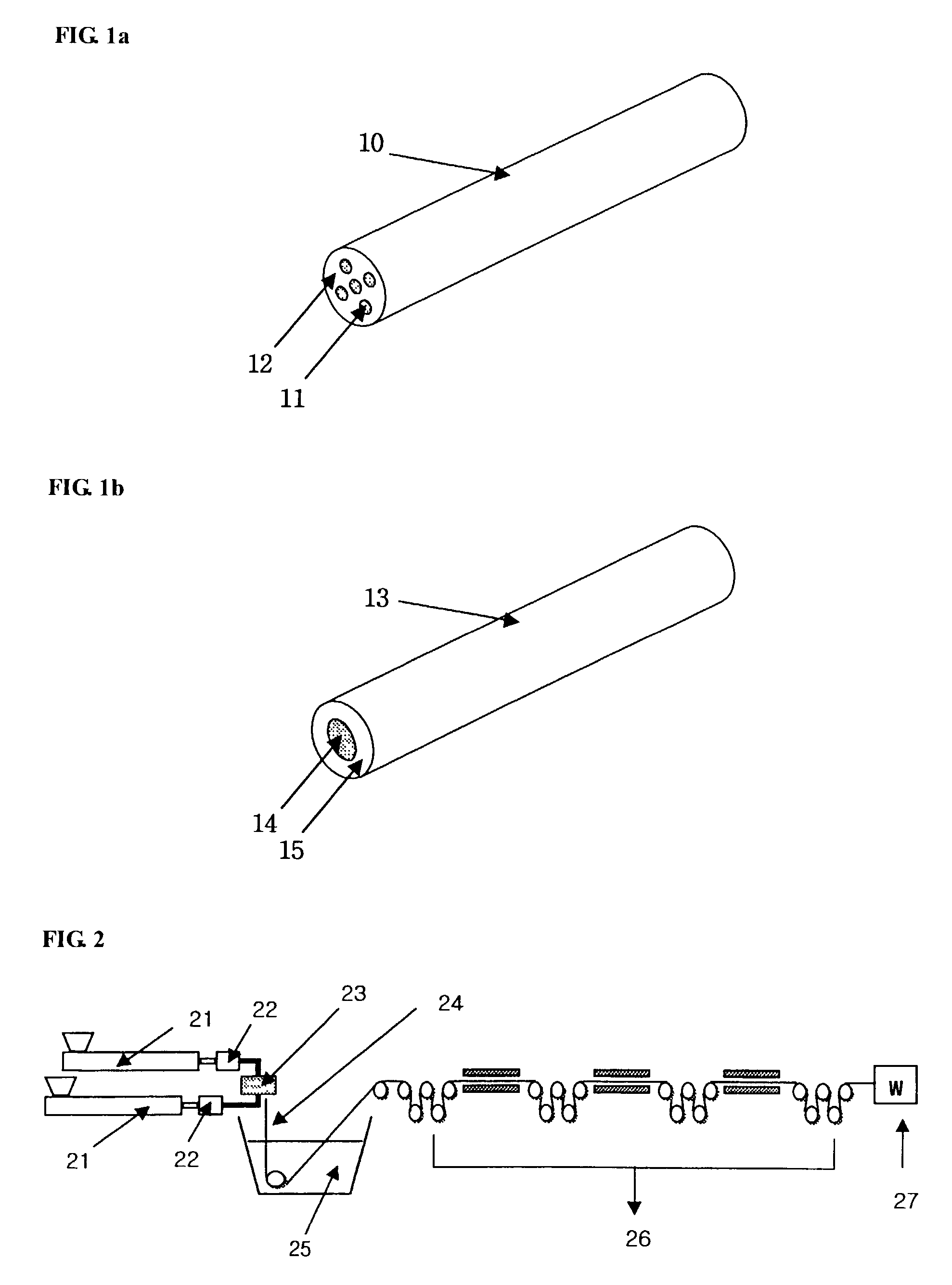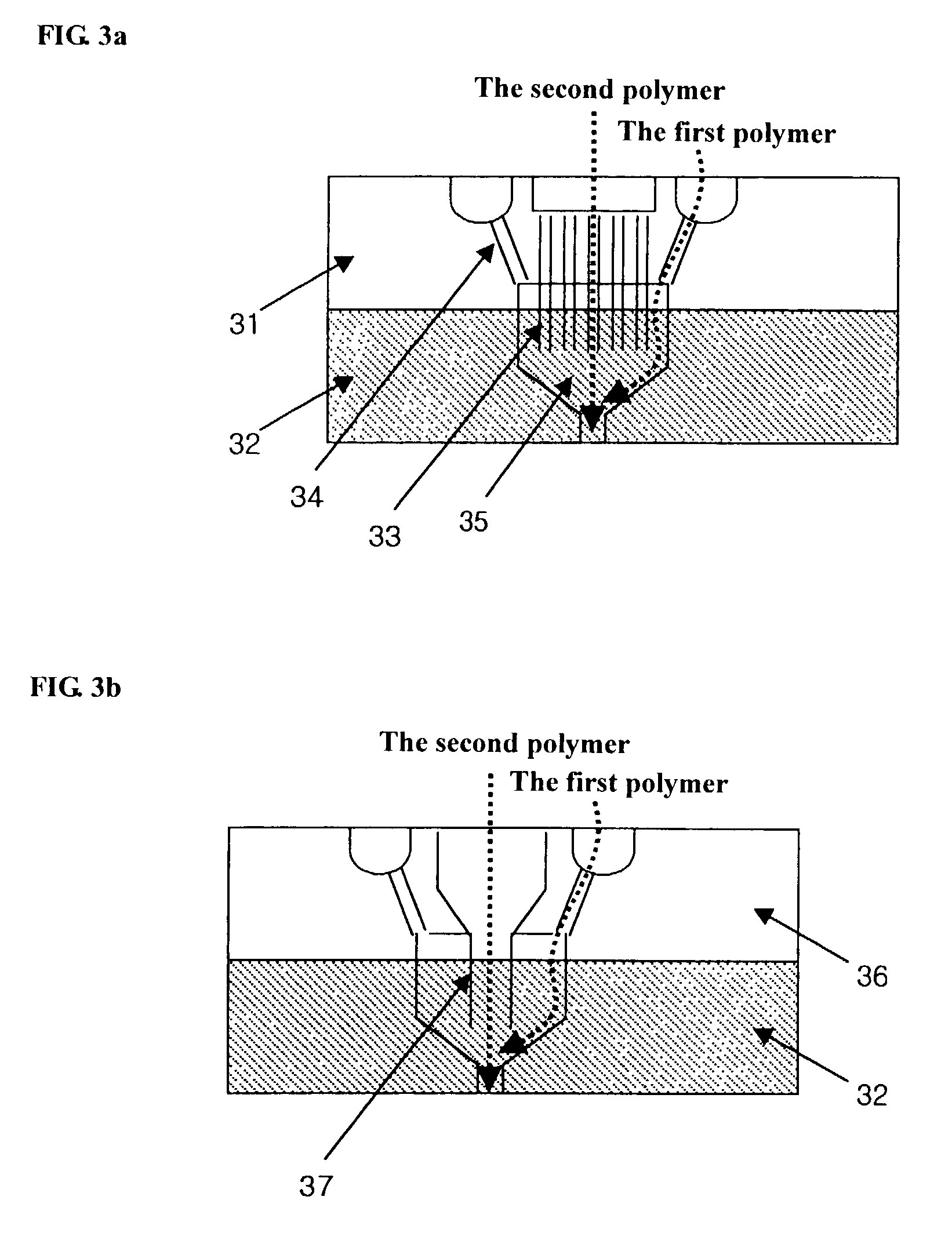Monofilament suture and manufacturing method thereof
a technology of monofilament and manufacturing method, which is applied in the field of monofilament sutures, can solve the problems of less flexible, lack of capillary capillary, and lack of monofilament sutures, and achieve the effects of promoting wound repair and/or tissue growth, excellent knot security and flexibility, and improving knot security and flexibility
- Summary
- Abstract
- Description
- Claims
- Application Information
AI Technical Summary
Benefits of technology
Problems solved by technology
Method used
Image
Examples
example 1
[0052]In this example, polydioxanone was used as the first polymer and polycaprolactone as the second polymer. A sea / island type monofilament suture was prepared in accordance with the parameters, terms and conditions as set forth in Table 2 below. By the method for measuring the physical properties explained above, diameter, knot strength, stiffness and knot slippage ratio of the prepared suture were measured.
[0053]
TABLE 2Conditions of Processing the Sea / Island Type Co-extruded SutureSuture SizeEP 4PolymerPolycaprolactonePolydioxanoneYoung's modulus (GPa)0.71.3Melting Point (° C.)55~6595~110Process ConditionsExtrusion ConditionsExtruderExt. 1 (Island)Ext. 2 (Sea)Number of Island Component19—Extruder screw, rpm7.511.4Manifold* pressure (kgf / cm2)8080Temperature of Extruder (° C.)Zone 1175180Zone 2178183Zone 3180185Temperature of Manifold (° C.)180185Temperature of Metering pump (° C.)180185Temperature of Nozzle Pack Die185(° C.)Capacity of Metering pump (cc / rev)1.21.2Revolution of Me...
example 2
[0054]In this example, a copolymer of glycolic acid and caprolactone was used as the first polymer and polycaprolactone was used as the second polymer. A sea / island type monofilament suture was prepared in accordance with the parameters, terms and conditions as set forth in Table 3 below. Using the method for measuring the physical properties explained above, diameter, knot strength, stiffness and knot slippage ratio of the prepared suture were measured.
[0055]
TABLE 3Conditions of Processing the Sea / Island Type Co-extruded SutureSuture SizeEP 4PolymerPolycaprolactoneCopolymer*Young's modulus (GPa)0.71.1Melting Point (° C.)55~65210~220Process ConditionsExtrusion ConditionsExtruderExt. 1 (Island)Ext. 2 (Sea)Number of Island Component19—Extruder screw, rpm7.622.3Manifold* pressure (kgf / cm2)8080Temperature of Extruder (° C.)Zone 1170210Zone 2180215Zone 3190220Temperature of Manifold (° C.)190230Temperature of Metering pump (° C.)190230Temperature of Nozzle Pack Die240(° C.)Capacity of Me...
example 3
[0056]In this example, polydioxanone was used as the first polymer and a copolymer of lactide and caprolactone were used as the second polymer. A sea / island type monofilament suture was prepared in accordance with the parameters, term and conditions as set forth in Table 4 below. Using the method for measuring the physical properties explained above, diameter, knot strength, stiffness and knot slippage ratio of the prepared suture were measured.
[0057]
TABLE 4Conditions of Processing the Sea / Island Type Co-extruded SutureSuture SizeEP 3PolymerCopolymer*PolydioxanoneYoung's modulus (GPa)0.61.3Melting Point (° C.)Amorphous95~110Process ConditionsExtrusion ConditionsExtruderExt. 1 (Island)Ext. 2 (Sea)Number of Island Component37—Extruder screw, rpm7.311.5Manifold* pressure (kgf / cm2)8080Temperature of Extruder (° C.)Zone 1140180Zone 2145183Zone 3150185Temperature of Manifold (° C.)150185Temperature of Metering pump (° C.)150185Temperature of Nozzle Pack Die (° C.)185Capacity of Metering p...
PUM
| Property | Measurement | Unit |
|---|---|---|
| Pressure | aaaaa | aaaaa |
| Pressure | aaaaa | aaaaa |
| Pressure | aaaaa | aaaaa |
Abstract
Description
Claims
Application Information
 Login to View More
Login to View More - R&D
- Intellectual Property
- Life Sciences
- Materials
- Tech Scout
- Unparalleled Data Quality
- Higher Quality Content
- 60% Fewer Hallucinations
Browse by: Latest US Patents, China's latest patents, Technical Efficacy Thesaurus, Application Domain, Technology Topic, Popular Technical Reports.
© 2025 PatSnap. All rights reserved.Legal|Privacy policy|Modern Slavery Act Transparency Statement|Sitemap|About US| Contact US: help@patsnap.com



